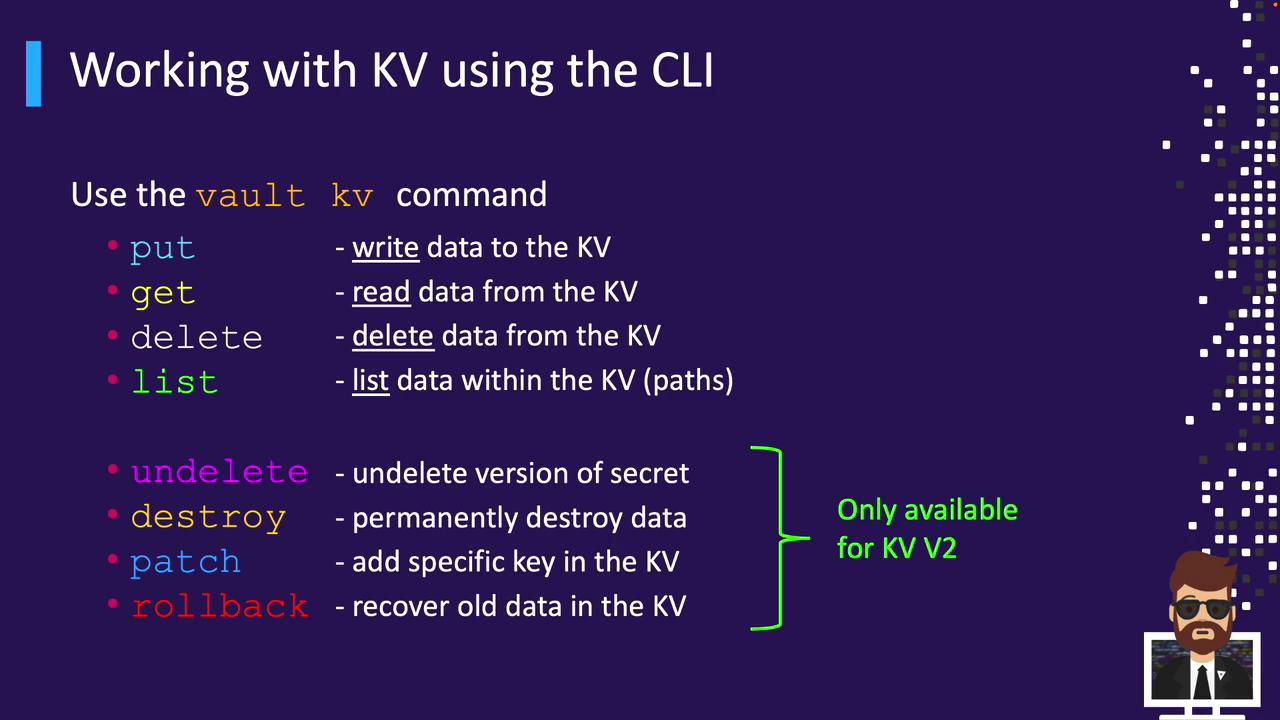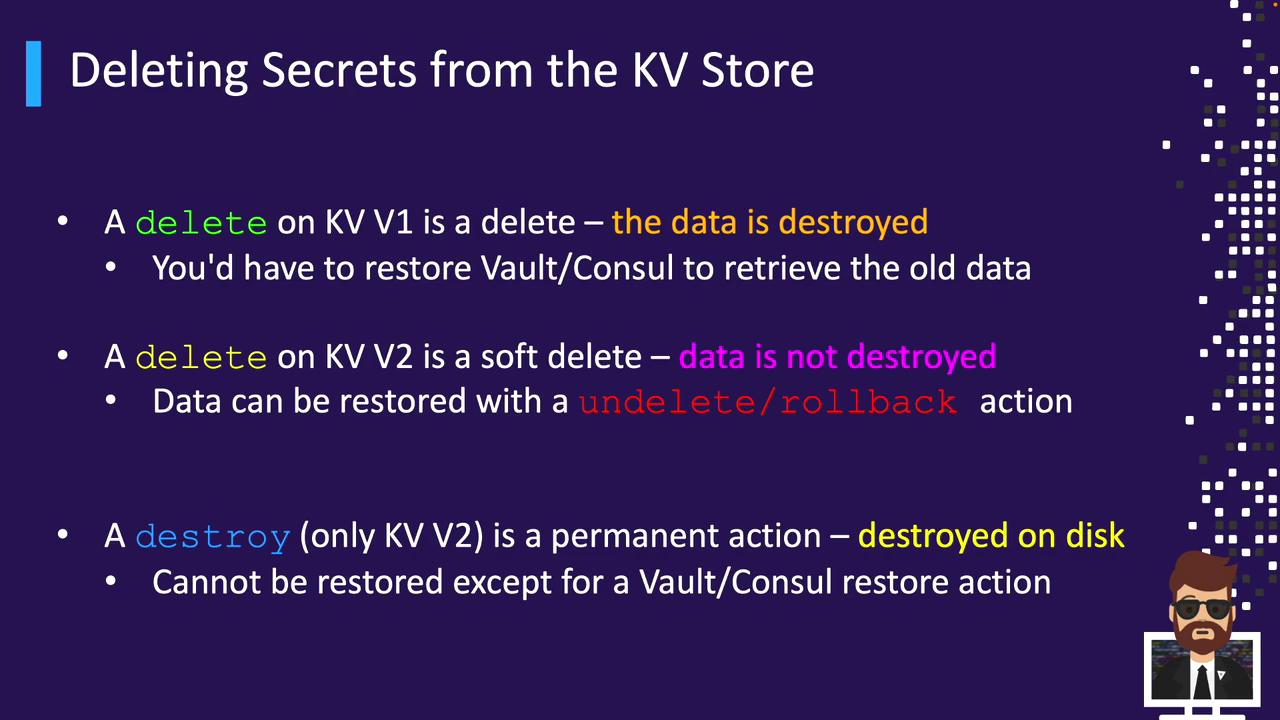HashiCorp Certified: Vault Associate Certification
Compare and Configure Secrets Engines
Working with KV Secrets Engine
In this guide, you’ll learn how to manage secrets with Vault’s Key/Value (KV) Secrets Engine using the vault kv CLI. We’ll cover KV version 1 and version 2 operations:
- Core commands:
put,get,delete,list - KV V2–only versioning commands:
undelete,destroy,patch,rollback
Master these commands to automate secrets management in scripts and CI/CD pipelines.
KV CLI Command Overview
Use vault kv <subcommand> to perform KV operations. The table below summarizes each subcommand:
| Subcommand | Description |
|---|---|
| put | Write or update secrets |
| get | Read secrets |
| delete | Remove latest version (soft delete in V2) |
| list | List child keys |
| undelete | Restore deleted version (KV V2 only) |
| destroy | Permanently delete specific versions |
| patch | Merge fields into an existing version |
| rollback | Revert to a previous version (KV V2) |

Writing Data with vault kv put
Use vault kv put to store or update secrets. The syntax is:
vault kv put <mount-path>/<secret-path> key1=value1 key2=value2 ...
<mount-path>/<secret-path>: The mount and path for your secretkey=value: Each key/value pair becomes a field in the secret
KV Version 1 vs. Version 2
KV V1 Example
$ vault kv put kv/app/db pass=123
Success! Data written to: kv/app/db
KV V2 Example
$ vault kv put kv/app/db pass=123
Key Value
--- -----
creation_time 2022-12-15T04:35:56.395821Z
deletion_time n/a
destroyed false
version 1
On KV V2, put returns extra metadata (creation time, deletion time, destroyed flag, and version).
Writing Multiple Pairs or JSON Files
Inline multiple pairs:
$ vault kv put kv/app/db pass=123 user=admin api=a8ee4b50cce124
Success! Data written to: kv/app/db
JSON File Input
You can also read key/value pairs from a JSON file:
$ vault kv put kv/app/db @secrets.json
secrets.json example:
{"pass":"123","user":"admin","api":"a8ee4b50cce124"}
Reading Data with vault kv get
Retrieve secrets in table or JSON format.
Table Output
KV V1
$ vault kv get kv/app/db
====== Data ======
Key Value
---- -----
pass 123
user admin
api a8ee4b50cce124
KV V2
$ vault kv get kv/app/db
===== Metadata =====
Key Value
--- -----
creation_time 2022-12-15T04:35:56.395821Z
deletion_time n/a
destroyed false
version 1
===== Data =====
Key Value
--- -----
pass 123
user admin
api a8ee4b50cce124
JSON Output for Automation
$ vault kv get -format=json kv/app/db
Pipe to jq for CI/CD automation:
vault kv get -format=json kv/app/db | jq '.data.data'
Reading Specific Versions (KV V2)
- Default (latest):
vault kv get kv/app/db - Specific:
vault kv get -version=3 kv/app/db
If the latest version is soft‐deleted, only metadata is returned.
Updating Secrets
Overwrite with put
A full put replaces all fields:
$ vault kv put kv/app/db api=new-api-key
Key Value
--- -----
version 2
Existing fields are lost; only the new api remains in version 2.
Revert Changes with rollback (KV V2)
$ vault kv rollback -version=1 kv/app/db
Key Value
--- -----
version 3
This creates version 3 with data from version 1.
Merge Fields with patch (KV V2)
$ vault kv patch kv/app/db user=bryan
======= Metadata =======
Key Value
--- -----
version 4
patch adds or updates fields without removing existing data.
Deleting Secrets

Soft Delete with delete
- KV V1: Permanently removes data
- KV V2: Marks the latest version as deleted (soft delete)
$ vault kv delete secret/app/database
Success! Data deleted (if it existed) at: secret/app/database
After Delete
KV V1:
$ vault kv get secret/app/database
No value found at secret/app/database
KV V2:
$ vault kv get secret/app/database
===== Metadata =====
Key Value
--- -----
version 3
deletion_time 2022-12-15T17:42:03.369955Z
destroyed false
# No Data table shown
Permanent Removal with destroy (KV V2)
Warning
destroy permanently deletes specified versions. This action cannot be undone.
$ vault kv destroy -versions=3 secret/app/web
Success! Data destroyed at: secret/app/web
Remove All Versions and Metadata
$ vault kv metadata delete secret/app/web
Success! All metadata and versions deleted at: secret/app/web
You’ve now mastered the KV Secrets Engine CLI operations for both KV V1 and KV V2. Next up: exploring the Transit Secrets Engine for encryption-as-a-service.
Links and References
Watch Video
Watch video content